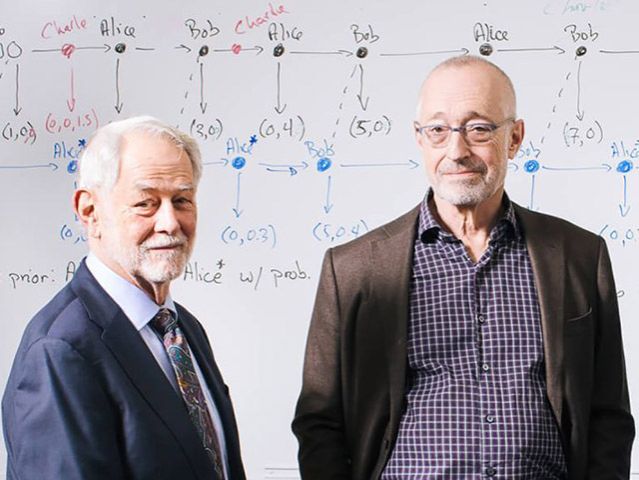Seminar with some reflections on the 2020 Nobel Prize in Economic Sciences

The Nobel Prize in Economic Sciences 2020 was awarded to Paul Milgrom and Robert Wilson for their “improvements to auction theory and inventions of new auction formats” (Royal Academy of Science, 2020).
Paul Milgrom and Robert Wilson have studied how auctions work. They have also used their insights to design new auction formats for goods and services that are difficult to sell in a traditional way, such as radio frequencies. Their discoveries have benefitted sellers, buyers and taxpayers around the world.
(Source: The Nobel Prize Organisation)
On the 10th of December, in occasion of the Nobel Prize ceremony that took place in Stockholm that same day, the EEF department at FEB hosted an online seminar in which Marco Haan (University of Groningen) and Maarten Janssen (University of Vienna) discussed some of the most salient and controversial aspects of this research program.
Private values
Marco Haan first started with some background history and essentials in the field of auctions. Auction theory started with Vickrey, who in 1960 analyzed auctions with private values: everyone has a certain appreciation for a good, knows how much it is worth to him, but does not know about the others. In this set-up, Vickrey showed revenue equivalence holds; with rational bidders, the expected revenue for the auctioneer does not depend on the type of auction and expected revenue equals the expected value of the second-highest valuation. Vickrey received the Nobel Prize for this in 1996.
Common values
Wilson analyzed auctions with common values. In this case, the object is worth the same for everyone. Nobody knows exactly what that value is, but can make an estimate. That sounds strange, but a classic example is the right to drill for oil in a specific area. Its value is unknown: it depends on how much oil is in the ground and how easy it is to get out. But for any bidding oil company, the right will have roughly the same value. In such an auction there is a risk of the winner's curse: the one who wins the auction will be the one who most overestimated the true value. So a smart bidder does not make an offer on the assumption that his offer is a reasonable estimate, but on the assumption that he has the greatest overestimate.
Affiliated values
As is often the case in life, the truth will be somewhere in the middle. Take the auction of a house; what someone is willing to pay for this, will partly depend on how much the bidder wants to live there (a private value component) but also on what the bidder thinks the house will yield when she sells it again in about 15 years (a common value component). This combination is called affiliated values and was analyzed by Milgrom and Weber.
Special aspects
Maarten Janssen (University of Vienna) talked about the special aspects of auctions.
Auctions are artificially created markets, where no previous markets existed (i.e. selling an antique painting). An auction is a conscious act that can be chosen among alternatives (beauty contest, lottery, grandfathering rights, etc.). The auction “organizer” can choose different designs and has to think about objectives and how to allocate resources.
Once casted in this way, many applications can arise; how to allocate emission permits, who should get the right to use certain spectrum frequencies, who should get the right to advertise on an internet page, who should get supply contracts in B2B markets and which party should get the rights for drilling for natural resources? Context is then an important factor.
Multi-unit auctions
With multi-unit auctions, the design of an auction becomes especially hard. Often, multiple units have to be allocated at once, like runway slots at airports, or telecommunication companies that want to get multiple blocks of spectrum, and have little value for just one block. One of the most popular auctions in this context is the simultaneous multiple round auction (SMRA).
Milgrom and Wilson were also on the team of economists that designed the auctions for US mobile frequencies in the early 1990s. This is complicated because several frequencies are being auctioned there, and those frequencies (and therefore auctions) are interrelated. They came up with a “simultaneous ascending auction”, in which all frequencies are auctioned simultaneously in several rounds, but bidders are allowed to switch from one frequency to another during the auction. The auction was hugely successful and was subsequently used in the Netherlands, for example.
Concluding remarks
Depending on the context, auction designs should incorporate some of the complexities, because not all auctions are as simple as an antique auction and therefore quite a bit of ingenuity is required. Whether we want it or not, our daily lifes are permeated with auctions. It’s important that they are designed well, depending on the context.
The work of the 2020 Nobel Prize laureates helped us to better understand the design of auctions, and which factors should be taken into account. Their work is not about making predictions. Anyhow, it is hard to know what the counterfactual is, i.e., what the outcome would have been without the work of the laureates. Their success lies in using microeconomic theory to design new mechanisms to allocate resources.
Together with the 2007 and 2012 Nobel Prizes for mechanism design and market design, this year’s award testifies a shift in the economics profession towards creating new markets rather than just studying existing ones.
So, it was about time for this prize!

